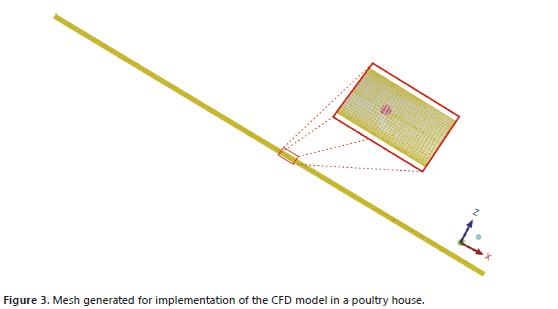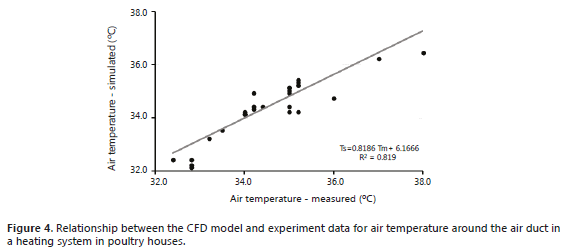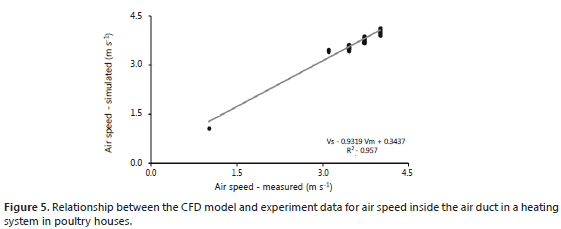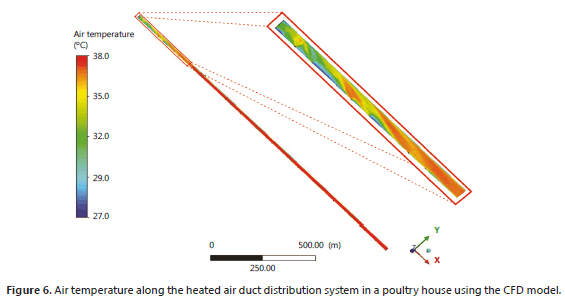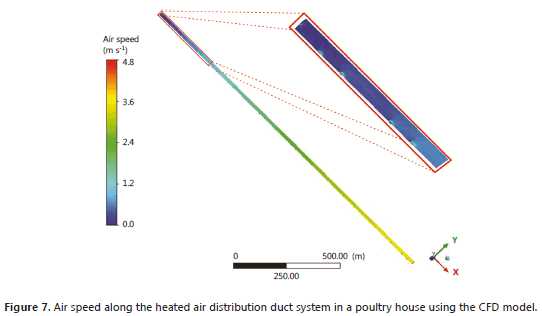Serviços Personalizados
Journal
Artigo
Indicadores
-
 Citado por SciELO
Citado por SciELO -
 Acessos
Acessos
Links relacionados
-
 Citado por Google
Citado por Google -
 Similares em
SciELO
Similares em
SciELO -
 Similares em Google
Similares em Google
Compartilhar
Revista Facultad Nacional de Agronomía Medellín
versão impressa ISSN 0304-2847
Rev. Fac. Nac. Agron. Medellín vol.67 no.2 Medellín jun./dez. 2014
https://doi.org/10.15446/rfnam.v67n2.44178
http://dx.doi.org/10.15446/rfnam.v67n2.44178
Evaluation of a Heating System in Poultry Houses Using a CFD Model
Evaluación de un Sistema de Calefacción en Galpones Avícolas Usando un Modelo en DFC
Flávio Alves Damasceno1; Jairo Alexander Osório Saraz2; Luciano Barreto Mendes3; Samuel Martin4 and Marcio Arêdes Martins5
1 Assistant Professor. Universidade Federal de Mato Grosso, UFMT - Instituto de Ciências Agrárias e Ambientais (ICAA). Campus de Rondonópolis. Rodovia Rondonópolis, Guiratinga, km 06 (MT-270), CEP 78735-910, Mato Grosso, Brazil. <damascenoufmt@gmail.com.br>
2 Associate Professor. Universidad Nacional de Colombia - Sede Medellín - Facultad de Ciencias Agrarias - Departamento de Ingeniería Agricola y Alimentos. A.A. 1779, Medellin, Colombia. <aosorio@unal.edu.co>
3 Agricultural Engineer. Universidade Federal de Viçosa - Departamento de Engenharia Agrícola. Campus UFV 36570-000, Vicosa, MG, Brasil. <luciano.mendes@ufv.br>
4 Associate Professor. Universidade de Brasília - Faculdade de Agronomia e Medicina Veterinária. Campus Universitário Darcy Ribeiro, CEP 70910-900, Brasilia, DF, Brazil. <samuelmartin@unb.br>
5 Associate Professor. Universidade Federal de Viçosa - Departamento de Engenharia Agrícola. Campus UFV 36570-000, Vicosa, MG, Brasil. <aredes@ufv.br>
Received: February 17, 2013; accepted: September 18, 2013.
Abstract. The objective of this study was to adapt and validate a computer model using the Computational Fluid Dinamics (CFD), in the prediction of temperature and air speed in a duct distribution system coupled to a heating furnace that is used in typical poultry houses in tropical and subtropical countries. The validation of the model with experimental data was satisfactory, presenting normalized mean square error NMSE values of 0.25 and 0.02 for air temperature and air speed, respectively. The results evidenced that the proposed model is adequate for predicting the air speed and temperature for this type of system, and could be used to improve the efficiency of the distribution of heat inside and around air ducts using different air speeds, types of materials and dimensions.
Key words: Animal welfare, energy efficiency, aviculture.
Resumen. El objetivo de este estudio fue adaptar y validar un modelo computacional haciendo uso de la dinámica de fluidos computacional (DFC) para predecir la temperatura y la velocidad del aire en un sistema de distribución de ductos acoplado a un sitema de calefacción que es utilizado en las instalaciones avícola en los países tropicales y subtropicales. La validación del modelo con los datos experimentales fue satisfactoria, presentando valores medios normalizados del error cuadrado NMSE de 0,25 y 0,02 para la temperatura y velocidad del aire respectivamente. Los resultados muestran que el modelo propuesto es adecuado para predecir la velocidad del aire y la temperatura alrededor de este tipo de sistema, y podría ser utilizado para mejorar la eficiencia la distribución de calor en el interior y alrededor de los conductos, usando diferentes velocidades, tipos de materiales y dimensiones.
Palabras clave: Bienestar animal, eficiencia energética, avicultura.

Birds are homeothermic animals; in other words, they are able to maintain their body temperature at an approximately constant level through physiological and behavioral mechanisms within very narrow limits (Damasceno et al., 2010). In their initial phase of life, the thermoregulatory system of birds is not fully developed, so they require a higher ambient temperature, making heating systems an essential feature of the environment in which they are housed (Baêta and Souza, 2010).
According to Machado (1994), during the winter time in many Brazilian regions, it is difficult to maintain the target comfort temperature for chicks, which in the first week should be around 32 oC. The dificulty arises from the large differences between inside barn temperatures that are considered ideal for chicks and outside barn temperatures, along with non-satisfactory heating system controls.
Thus, maintaining temperatures inside the barn at appropriate levels is crucial for the welfare of broilers, since, at their early life stages, these animals require a higher temperature to maintain the minimal metabolic rate and continue homeothermy with the least energy expenditure. A solution for this issue is heating air up to the second or third week of rearing, depending on weather conditions; this could be done with various energy sources, such as liquefied petroleum gas (LPG), coal and, especially, firewood (Abreu, 2003).
Heaters have been designed in various forms over time and are used by farmers in order to provide heated air to the birds and, hence, provide the thermal comfort necessary for their proper body development. Improvements and maintenance are usually needed to keep the air heating systems efficient and functional (Zanatta et al., 2008).
In order to evaluate and compare heating systems in poultry houses, several field studies have been conducted, such as those of Ferreira (2004), Vigoderis (2006) and Zanatta et al. (2008). However, several limitations exist, such as the difficulty in finding enough barns with similar heating systems in one location and the high costs of experiments, among others, which do not allow for studies covering a large number of variables and factors, or factor levels, to be tested in the field. Thus, a potential answer to the problem may be the use of properly validated computer simulations in the first phase followed by testing in the field of the treatments of interest.
Computational fluid dynamics (CFD) have the potential of quantifying, effectively and accurately, climatic variables inside animal houses and have been used by several authors (Roy and Boulard, 2005; Norton et al., 2007; Kim et al., 2008; Osorio, 2012; Damasceno, 2012). Several design conditions can be tested within a virtual environment, reducing the number of physical experiments. Spatial and temporal solutions for fluid pressure, temperature and speed can be readily reproduced via CFD similulations.
Therefore, the aim of the present study was to validate a computer model with Computational Fluid Dynamics (CFD) to predict the temperature and air speed around a heated air distribution system applicable in poultry barns.
MATERIAL AND METHODS
The experimental study was conducted in a poultry barn equipped with a positive pressure ventilation system located in the municipality of Viçosa (Brazil), with the geographic coordinates of 20°45'45'' S and 45°52'04'' W, at an altitude of 651 masl. According to the climate classification of Köppen, the climate is a Cwa type, with hot weather, rainy climate, and a dry season in the winter and a hot, humid summer.
The poultry barn had the dimensions of 13.0 m Width X 100.0 m Length X 2.9 m Height, wherein 15,380 male chicks of the Avian lineage were housed, at a stocking density of 11.8 birds m-2. The ventilation system was composed of 13 fans at a flow rate of 18,000 m3 h-1 each, positioned on one side of the barn (cross ventilation). Pendulum type feeders and waterers were used.
The heating system of the poultry barn consisted of indirectly heated air with a firewood furnace, which was placed inside the barn, with the heated air distributed by two ducts made of galvanized steel (16.8 m length, 0.16 m diameter and 0.002 m thickness). Along the ducts, 16 holes with diameters of 0.05 m each were equally spaced.
For this study, data on air temperature (tbs) and relative humidity (RH) at intervals of 2 min for a 5 days period was collected with model HO8, HOBO datalogger pre-programable portable (accuracy: ± 0.2°C for temperature and ± 3% for relative humidity; temperature range of -30°C to + 50°C and humidity of 0% to 100%; HOBO®, model H8, Pocasset, MA, USA), allocated near the furnace at 0.3 m from the floor, i.e. at the influence zone of the birds.
The temperature of the inlet air duct (tinlet), the duct surface temperature (tsurface) and air speed (vair) were also collected every 30-min during a 5-days period, whenever the system was in operation. The monitoring of tinlet, vai and tsurface was done at 32 sites distributed around the air distribution duct (Figure 1), 0.3 m above the floor. Data on tinlet and vai were measured with a hot wire anemometer with a range of 0 to 50 m s-1 (Testo®, model 425, Sparta, NJ, USA, accuracy of ± 0.5 °C and ± 0.03 m s-1) and the tsurface was measured with an infrared thermometer (Fluke®, model 62, Everett, WA, USA, accuracy: ± 1°C).
Geometry. The initial stage of simulations in CFDs is the definition of the domain, i.e. the geometry in which to apply the numerical solution of the equations that describes the phenomena to be investigated.
Domain geometry for this study was generated with the Rhinoceros 4.0 software and the simulations were performed with the ANSYS11version 12 software. The temporary license and software package of ANSYS was owned by the Department of Agricultural Engineering, Federal University of Viçosa - Brazil.
Computational mesh. To improve the CFD accuracy, the study exerted much effort to find the appropriate mesh quality and density and optimum setting condition of air temperature and speed. The mesh quality is very important for obtaining accurate data and computational convergence. Thus, due to the geometric complexity of the hole diameters distributed along the duct, in this study, tetrahedral cells with a scale of 1.0 and 10.0 were used. ANSYS ICEM CFD® software was used for construction of the mesh, which allows for obtaining results with fewer errors (Lee et al., 2007). This software has been specifically designed to fulfill the task of automatically generating high quality tetrahedral meshes, which are suitable for scientific computing, using numerical methods such as finite volume methods.
Numeric modeling. Air flow rates are usually associated with turbulent flows and, when combined with heat transfer interactions, generate a system of equations that is difficult to solve, especially by non-numeric methods. Thus, the CFD technique used in this study was based on the solution of the Reynolds number average system extracted from the Navier - Stokes equations, by discretizing the flow field and based on the finite volumes technique.
The model that describes the non-isothermal fluid flow is described by the equations of continuity, momentum and energy, simplified in the following forms (Fluent, 2004; Ahmadi and Hashemabadi, 2008):

The turbulent flow was modeled using the k-e standard model, which evaluates the viscosity (μt) from the relationship between the turbulent kinetic energy (k) and dissipation of turbulent kinetic energy e (Lee et al., 2007).

Where the values of k-e are obtained by equations 5 and 6:

Boundary conditions. The ANSYS CFx software was used in the simulations and the assumptions were as follows: steady state; single-phase flow (fluid: air); thermal energy condition; incompressible and turbulent flow. The local coefficient h did not have significant changes in any of the ducts; thus, the overall heat transfer coefficient was considered to be constant (Figure 2).
Validation of the simulated solution with the experimental data was done with the mean residue for linear systems technique (RMS, root mean square), with a tolerance of 10-4 as the convergence criterion. Additionally, the dimensions and operating conditions of the air distribution duct model were used to generate the CFD model. Hence, the measured values of air temperature and speed obtained in the experimental barn for boundary conditions were averaged out and implemented in the computational model as presented in Table 1.
The results of the CFD model were checked and compared with the corresponding data obtained experimentally. The agreement between the experimental and model data was evaluated with the normalized mean square error (NMSE) as recommended by ASTM (2002) (equations 7 and 8), and has been used to assess the validation of the computational model in various studies with CFD (Zhao m et al., 2007; Demaël and Carissimo, 2007; Osorio, 2010; Osorio et al., 2012). For this study, the NMSE was calculated over a sample size of 160 data points. The model fit between measured values and the numerical result by the CFD simulation was evaluated by calculating the normalized mean square error (NMSE) where values of NMSE less than 0.25 are accepted as good indicators of fit according Osorio et al. (2012).
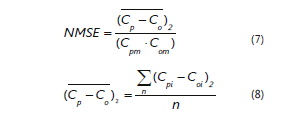
Where: Cpi is the predicted value; Coi is the observed value; Cpm is the average predicted value; Com is the average observed value and n is the number of measurements.
RESULTS AND DISCUSSION
Tests with different hexagonal mesh sizes were conducted until there were no significant differences between the measured and simulated data (P<0.05). The best result was obtained using a mesh of 997,163 hexahedral elements (Figure 3), designed and used as the computational domain, which consisted of a system with 750,577 nodes. That mesh was refined in the perforations along the duct, as necessary for obtaining more detail in those points of interest. The Reynolds number for the proposed problem was 1.0719 x 107, which indicated a turbulent flow inside the air duct distribution, as was expected.
The data obtained by the CFD model and experimental data indicated that the mean values of air temperature and speed obtained from the experimental values, showing NMSE values of 0.25 and 0.02, respectively. This indicates that there is good agreement between the results, leading one to conclude that the developed CFD model can be used to predict the average behavior of the air temperature and speed along the heat distribution duct (Table 2).
The results of the difference between the model and experimental values of air temperature around the duct were equal to 0, in favor of Ho (P=0.100). The correlation coefficient between the experimental and model data, when fit to a linear model, was 0.819, with the regressed model explaining much of the change in these two variables (F test, P<0.0001), providing an average error of 34 ± 1 °C (Figure 4). The relationship between the experiment and model air temperature data is illustrated in Figure 4.
The average air speed at the orifices along the duct calculated with the CFD model was 3.7 m s-1 and did not differ significantly (simple t-test, P=0.4302) from the experimental mean air speed of 3.6 ± 0.2 m s-1. The linear model explained most of the variability of the model and experiment air speed (F test, P <0.0001), with a correlation coefficient of 0.957. Figure 5 illustrates the relationship between the measured and simulated air speeds obtained at different points along the air distribution duct.
Figure 6 shows the air temperature distribution inside the duct. It can be observed that the temperature of the air underwent a large variation, especially near the walls and at the extremities of the duct in a heating system in poultry houses.
According to Santos (2008), losses of energy through dissipation from heated air in semi-climatized environments with automated heating equipment may be due to the presence of cracks in the curtains, porosity of the roof and ceiling and the in- and outflows of workers. As a consequence, drops in temperatures occur very often, enhancing system inefficiency in maintaining internal air temperatures within the thermal comfort limit for birds.
According to the results found in this study, the material used to making the ducts, along with the exaggerated duct length, contributed to heat losses and reduced efficiency. The air speed distribution inside the ducts (Figure 7) was lower at the extremities; once again demonstrating the possible results due to the excessive diameters of the holes along the duct and the ineffectiveness of oversizing duct lengths when carrying heated air longer distances in poultry barns. A possible solution to this problem would be the use of shorter ducts with smaller diameters, constructed with materials that have lower heat transfer coefficients, such as PVC, fiberglass, silicone, and nylon, insulating the ducts, and carrying out future analyses with more detail in order to find the effect of perforations along ducts on system efficiency, among others.
CONCLUSIONS
The proposed CFD model was well validated with the experimental data and can be used to predict the dynamics of air dry bulb temperature and speed distribution inside heated air ducts in broiler houses.
Furthermore, the validated CFD model can be used to test different design configurations, types of materials, and inlet air temperatures and speeds, among other variables related to the heating systems of poultry houses that are considered the main source of the problems related to controlling the thermal environment in broiler houses.
BIBLIOGRAPHY
Abreu, P.G. 2003. Modelos de aquecimento. pp. 65-77. Em: IV Simpósio Brasil Sul de Avicultura. Chapecó, Santa Catarina. [ Links ]
Ahmadi, A.H. and S.H. Hashemabadi. 2008. 3D CFD simulation and experimental validation of particle-to-fluid heat transfer in a randomly packed bed of cylindrical particles. International Communications in Heat and Mass Transfer 35(9): 1183-1189. [ Links ]
ASTM. 2002. Guide for statistical evaluation of indoor air quality models (D5157-97). In ASTM Standards on Indoor Air quality, 2nd edition. pp. 68-71. West Conshohocken, Pa.: American Society for Testing Materials. [ Links ]
Baêta, F.C. e C.F. Souza. 2010. Ambiência em Edificações Rurais: Conforto Animal. Second edition, UFV., Viçosa. 269 p. [ Links ]
Damasceno, F.A. 2012. Compost bedded pack barns systems and computational simulation of airflow through naturally ventilated reduced model. Tese Doutorado Engenharia Agrícola. Universidade Federal de Viçosa, Viçosa. 391 p. [ Links ]
Damasceno, F.A., T. Yanagi Junior, R.R. Lima, R.C.C. Gomes e S.R.P. Moraes. 2010. Avaliação do bem-estar de frangos de corte em dois galpões comerciais climatizados. Ciência e Agrotecnologia 34(4): 1031-1038. [ Links ]
Demael, E. and B. Carissimo. 2007. Comparative evaluation of an Eulerian CFD and Gaussian plume models based on prairie grass dispersion experiment. Journal of Applied Meteorology and Climatology 47(1): 888-900. [ Links ]
Ferreira, W.P.M. 2004. Avaliação de uma fornalha a carvão vegetal para aquecimento de aviário. Tese Doutorado Engenharia Agrícola. Universidade Federal de Viçosa, Viçosa. 137 p. [ Links ]
Fluent. 2004. The manual of computational fluid dynamics (CFD), version 5.5. New Hampshire, USA. 545 p. [ Links ]
Kim, K., J. Yoon, H. Kwon, J. Han, J.E. Son, S. Nam, G.A. Giacomelli and I. Lee. 2008. 3-D CFD analysis of relative humidity distribution in greenhouse with a fog cooling system and refrigerative dehumidifiers. Biosystems Engineering 100(2): 245-255. [ Links ]
Lee, I.B., S. Sase and S.H. Sung. 2007. Evaluation of CFD accuracy for the ventilation study of a naturally ventilated broiler house. Japan Agricultural Research Quarterly 41(1): 53-64. [ Links ]
Machado, P.S. 1994. Manejo do 1o ao 28o dias. Em: Manejo de frangos. pp. 47-58. Fundação APINCO de Ciência e Tecnologia Avícolas FACTA, Campinas. [ Links ]
Norton, T., D. Sun, J. Grant, R. Fallon and V. Dodd. 2007. Applications of computational fluid dynamics (CFD) in the modelling and design of ventilation systems in the agricultural industry: A review. Bioresource Technology 98(12): 2386-2414. [ Links ]
Osorio, J.A., I. De F.F. Tinôco, K.S.O. Rocha, M.A. Martins e F.A. Damasceno, 2012. Validation of a CFD model for prediction of the efficiency of evaporative cooling in porous panels. Revista U.D.C.A Actualidad y Divulgación Científica 15(1): 209-217. [ Links ]
Osorio, J.A. 2010. Measurement and CFD modeling of ammonia concentration, flux and thermal environment variables in open side broiler housing. Tese Doutorado Engenharia Agrícola. Universidade Federal de Viçosa, Viçosa. 115 p. [ Links ]
Roy, J.C. and T. Boulard. 2005. CFD predictions of the natural ventilation in a tunnel type greenhouse: influence of wind direction and sensibility to turbulence models. Acta Horticulturae 691:457-464. [ Links ]
Santos, P.A. 2008. Qualidade do ar, conforto térmico e desempenho de frangos de corte em dois sistemas de aquecimento e de ventilação. Tese Doutorado em Engenharia Agrícola. Universidade Federal de Viçosa, Viçosa. 107 p. [ Links ]
Vigoderis, R.B. 2006. Sistemas de aquecimento de aviários e seus efeitos no conforto térmico ambiental, qualidade do ar e performance animal, em condições de inverno, na região sul do Brasil. Tese Doutorado em Engenharia Agrícola. Universidade Federal de Viçosa, Viçosa. 104 p. [ Links ]
Zanatta, F.L., J.N. Silva, I.F.F. Tinôco, D. Oliveira Filho e S. Martin. 2008. Avaliação do conforto térmico am aviário aquecido com gaseificador de biomassa. Engenharia na Agricultura 16: 270-284. [ Links ]
Zhao, J., H.B. Manbeck and D.J. Murphy. 2007. Computational fluid dynamics simulation and validation of H2S removal from fan-ventilated confined-space manure storages. Transactions of the ASABE 50(6): 1-16. [ Links ]
















